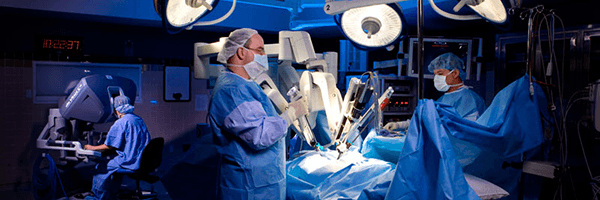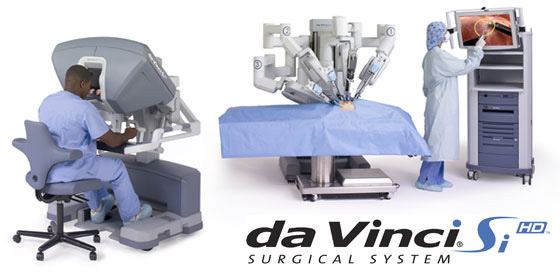Robotic surgery: revolution or gimmick?

Robotic technology has been used in surgeries for the last 15 years, is it sustainable?
Founded in 1995, Intuitive Surgical is the industry leader in robotic surgical systems that allow doctors to perform surgeries with the assistance of robotic technology.
Based on research that began in the late 1980s, the founders of Intuitive Surgical, armed with a war chest of VC funding began working on a prototype system code named “Lenny”. It took 5 years, but the device, now known as the da Vinci Surgical System, was approved by the FDA in 2000. The company went public that same year.
The potential for such a device was enormous, doctors would now be able to perform surgeries more accurately after being trained on the da Vinci system. Advocates envisioned a world where patients in remote areas would no longer have to travel for surgery, doctors would be able to dramatically improve the utilization of their skills by performing more surgeries across the globe, leading to an overall increase in the quality of healthcare globally. This generated a lot of buzz in the medical community and among investors. Those bet on the success of Intuitive Surgical would not be disappointed. The company now has a market capitalization just under $27B, with $2.4B in revenue generated in 2015.

Although the da Vinci system did not focus on allowing surgeries to be performed remotely, it did not take long for experts to test whether it was possible. Operation Lindbergh, named after Charles Lindbergh’s first ever transatlantic flight is widely regarded as the first true remote surgery. Conducted by a doctor in New York on a patient in Paris in 2001, this operation symbolized a new era of possibilities the medical world.
Challenges
Although the introduction of the da Vinci system and robotic surgery has been successful with sales growth increasing steadily since it’s launch, it did not come without its fair share of criticism.
“This is a technology that is costing the healthcare system hundreds of millions of dollars and has been marketed as a miracle — and it’s not.. It’s a fancier way of doing what we’ve always been able to do.”
Dr. John Santa, medical director at Consumer Reports Health.
“There’s a widespread belief that newer is better but our findings question that. People need to stop and critically analyze whether using this expensive technology will really add any benefit for patients,”
Jason D. Wright, chief of gynecologic oncology at Columbia
“So far, robotics has not lived up to the hype for benign gynecologic procedures.”
Barbara S. Levy, American College of Obstetricians and Gynecologists (ACOG) Vice President for Health Policy
Opportunities
In order to fully leverage the potential of their device, they will need to pivot their business model towards adding value in other ways. Improvements to digital technology and the wide proliferation of digital access present many opportunities for Intuitive Surgical.
- Development of more sophisticated digital technology, coupled with improvements in manufacturing will present an opportunity to drive down costs of the da Vinci system and access a wider market. A da Vinci system currently costs roughly $2 million dollars per unit in addition to maintenance and operating costs. This is prohibitive for many hospitals around the world which would benefit greatly from the device.
- Leveraging improving data transfer technologies will enable remote procedures to be conducted more effectively. This is the logical next step once protocols and procedures are developed to manage the process of conducting routine surgeries remotely.
- Training on the da Vinci system presents a unique opportunity to bring doctors together from around the world and develop a body of intelligence that would serve as a catalyst for improvements of surgical procedures worldwide. With all the data collected from thousands of procedures worldwide, Intuitive Surgical is uniquely positioned to take a leading role in the advancement of the field.
- Artificial intelligence married with robotic surgical devices presents a unique opportunity to eventually be able to perform procedures without the interference of a doctor. This will undoubtedly take significant time to develop, however it is not a stretch to see simple procedures being conducted by AI equipped da Vinci systems in the near future.
Overall I believe that robotic and remote healthcare represent an exciting frontier that will continue to generate greater benefits in the future. The key will be for robotic technologies to find more ways to add value to their customers by leveraging digital technologies rather than continue to deliver an expensive tool that mimics traditional surgeries.
(690 words)
References:
- intuitivesurgical.com
- http://www.wsj.com/articles/robotic-surgery-brings-higher-costs-more-complications-study-shows-1412715786
- http://www.wsj.com/news/articles/SB10001424127887323764804578314182573530720?KEYWORDS=intuitive%20surgical&mg=reno64-wsj
- roboticoncology.com
- https://www.theguardian.com/society/2002/oct/06/health.medicineandhealth
- http://www.healthline.com/health-news/is-da-vinci-robotic-surgery-revolution-or-ripoff-021215



What an interesting article! I agree that robotic technologies like the da Vinci system present an exciting opportunity in the healthcare system. Given that this device received FDA approval in 2000, though, I’m wondering why we haven’t yet seen a larger overhaul of traditional surgical methods? From what I can tell from Intuitive Surgical’s website, it sounds like a fairly large proportion of routine minimally invasive procedures are now conducted with the da Vinci system, but given that the technology has been around for almost two decades in a healthcare system where high spending is the norm, I’m surprised it isn’t more pervasive. Is the most significant barrier cost, or are there safety concerns associated with the device? I found a few articles online (e.g., http://www.bbc.com/news/technology-33609495) that call into question the safety of these technologies – where faulty or broken instruments are responsible for patient injury or death – but I’m curious how the average risk level of a traditional laparoscopic surgery compares statistically with that of surgery conducted by the da Vinci system.
Thanks for the post Ahmad! I think figuring out how to add value in other ways this robotic technology is indeed critical for Intuitive Surgical. Seems to me that larger hospitals will appreciate this technology better than smaller hospitals due to the sheer volume of these surgical procedures they perform, potential time savings as well as the perception of being best in class (from a marketing perspective). I am curious as to the cost component of this. Do these robotic surgical procedures cost more for patients? If so, how does Medicare or other insurers go about reimbursing the hospitals for robotic procedures versus normal ones? Does the hospital end up taking the hit for any excess costs or does that trickle down to patients? I imagine this could influence various hospitals’ willingness to adopt this technology.
Great post! I find it interesting the difference between investor enthusiasm and the skeptical comments of the doctors you quoted in the post. Though not a comprehensive view of all opinions, it does lead me to question precisely where robotics’ place is in surgical care. Sometimes fancy does not always mean better and in this case, the surgeon still seems to have a major role in the operation itself, bringing into question the extent to which a robotic system adds value and whether the expense is justified. A few supporting sentiments can be found in the WSJ link below, where in addition to highlighting the positives, some question the rapid adoption of robotic technology due to: “wow” factor, industry’s fascination by new technology, hospitals seeking saleable competitive advantage.
http://www.wsj.com/articles/SB10001424052702304655104579163430371597334
Great post, very intersting read! I find it amazing that so much criticism followed this type of innovation as I find it fascinating, but I had not heard the arguments presented in your post. I find it valid to question the actual “value add” provided by tools like the da Vinci Surgical System and whether the cost is warranted, but with to the extent that we can continue innovation in using technology to improve surgical procedures, I believe this is a great starting point and we should be celebrating these innovations. Moreover, I understand the delicate nature of using technology for remote surgical procedures, and agree with the fact that we need to be exigent on the levels of safety, but I think we need to embrace this type of inventions and give it time for them to become better and less costly so that they have the ability to truly change the way this segment the health industry works, for the better.
I think this is a very complex and fascinating innovation topic, and while reading it, it kind of reminded me of the IBM Watson case. I think the tremendous value of robotic surgery will become clear once the robot’s capabilities surpass the ones of the human surgeon, such as in cases of great precision (e.g., neurosurgery) or long-lasting extenuating procedures. But how does the development team progress to that point and how do they track it? They seem to be doing it incrementally, by starting with regular procedures, but I am afraid this might not be sufficiently “impressive” to guarantee the capital they need to progress towards the development of an actual break-through. I wonder if they shouldn’t try to focus on first developing some sort of intelligent tools for very delicate procedures, that can still be used by surgeons, and only once they have proven their superiority, evolve by adding the remote features and the “full surgeon” to the tool.
I have conflicting views on this. I agree that this is a revolutionary technology, and could benefit a lot of people – especially with its remote operating capabilities. I imagine this being a boon in India, where qualified surgeons could operate on people in more remote areas. However, I would be concerned on the sensitivity of these machines and how surgeons train on them. Surgeons who are great with their hands but not with their machine operating capabilities – do we loose out on them? I do think however that this technology should be worked upon and improved to give benefits in the long run
Thank you for sharing. I have personally witnessed multiple da Vinci procedures, and I do believe they are the way of the future. The technology improves the accuracy of the procedure. Da Vinci works because it is a combination of technology and physicians. During the procedure the physical is guiding the machine. I do believe that medical technology will one day result in only A.I. but i can’t stress enough the importance of having a physical human in the room. Also, I moving forward we should find a way to reduce the cost of improved technology like da Vinci. Yes the hospital takes the hit in terms of cost, but the results are priceless.
Thanks Ahmad! This article is very informative. It’s foreseeable that robotic and remote healthcare are the next exacting breakthroughs. Instead of repeating the same surgery procedures of surgeons, robotics can perform more complex procedures with higher precision and lower risks. Particularly, in surgeries that require longer operating time, using robotics, rather than surgeons, can also avoid any risks associated with fatigues. I see it as a complementary approach to current practice and needs constantly evolvement with the development of machine learning etc.